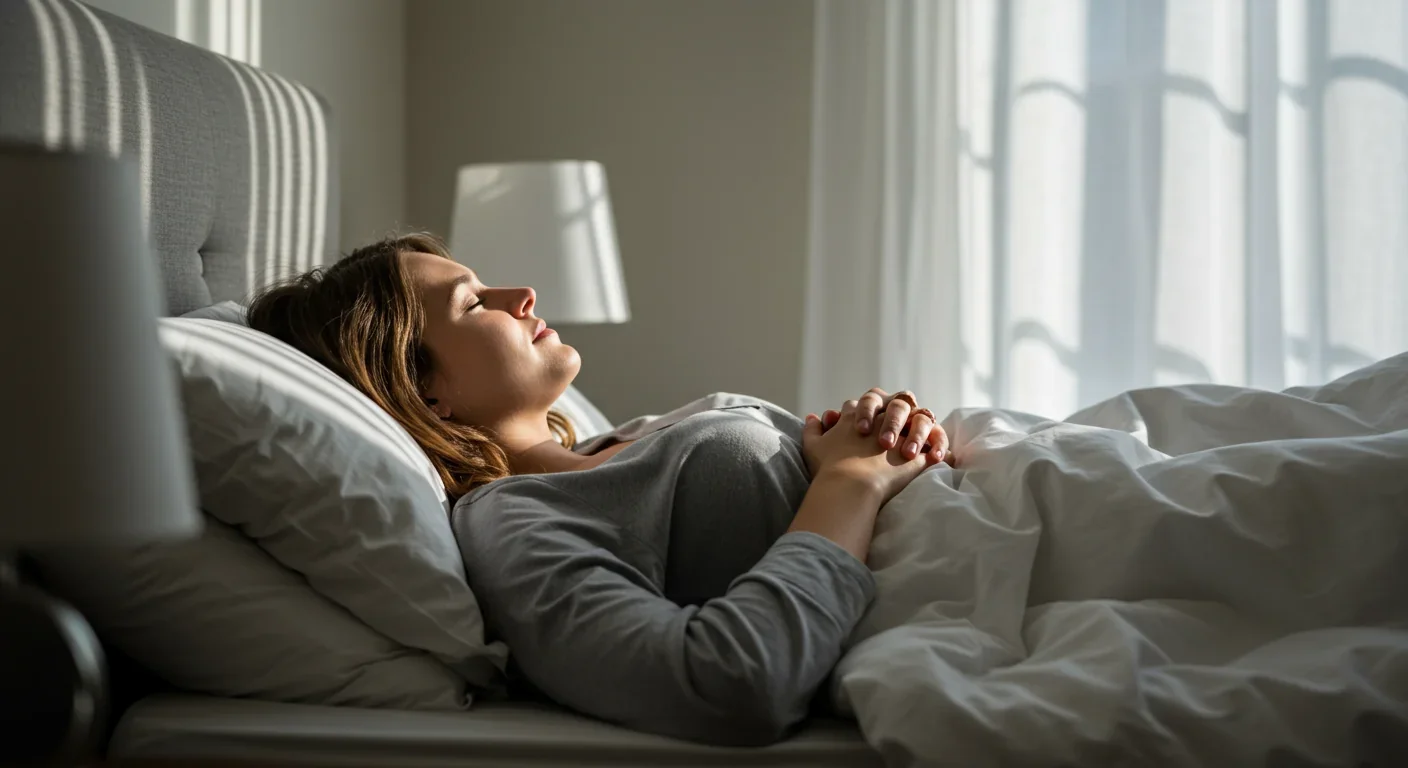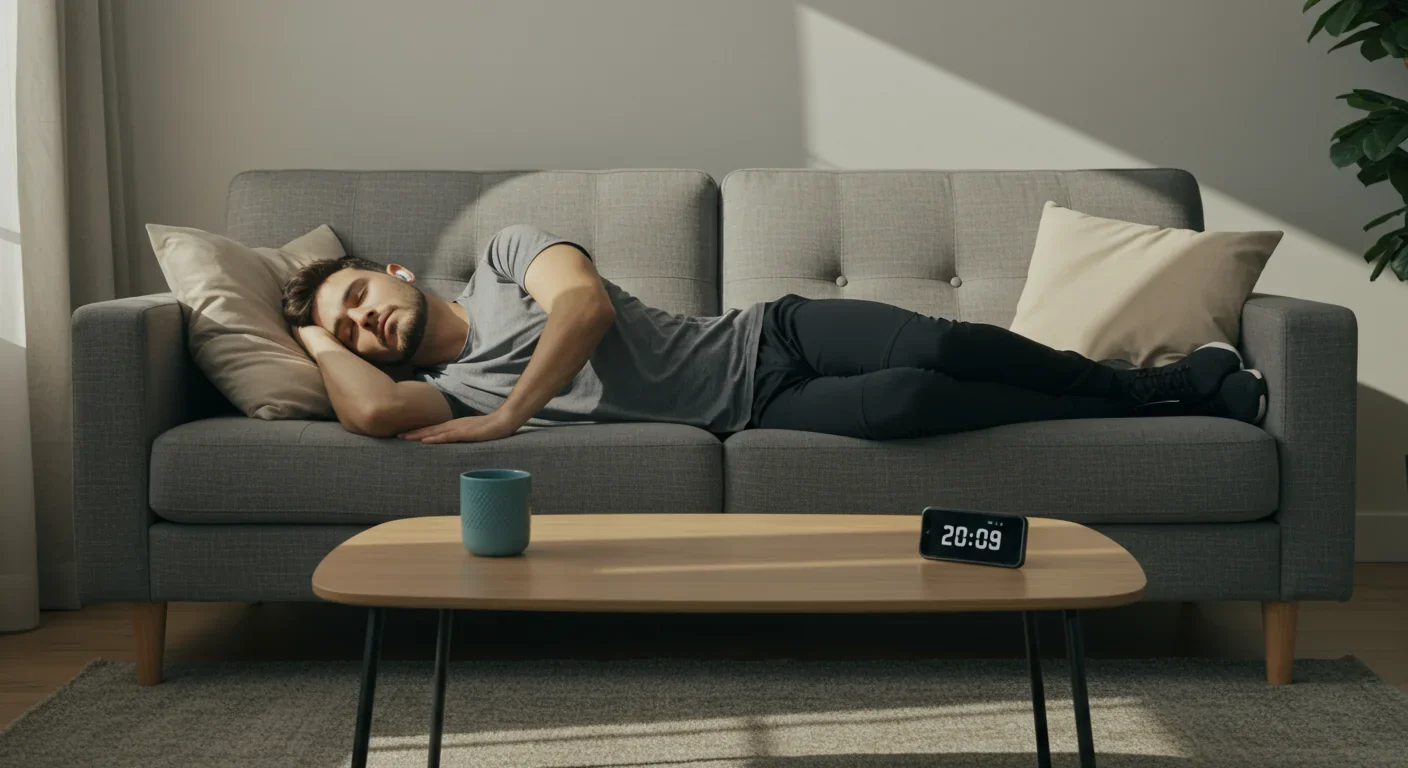Ultrafine Particles Breach Brain Barriers: Hidden Risk

TL;DR: Adenosine accumulates in your brain during wakefulness, creating natural sleep pressure. By optimizing caffeine timing, exercise schedules, light exposure, and temperature, you can harness this biological system to end insomnia without medication.

Within your brain right now, a molecular clock is ticking. Every second you stay awake, a compound called adenosine accumulates in your neurons, building pressure like water behind a dam. This pressure is your body's natural sleep drive, and understanding how to work with it could end your insomnia without a single prescription pill. Recent research reveals that manipulating adenosine through simple lifestyle changes can dramatically improve sleep quality.
Adenosine isn't just another neurotransmitter—it's the master regulator of your sleep-wake cycle. As researchers at the Sleep Foundation explain, adenosine is a byproduct of cellular energy metabolism. When your brain burns ATP, it releases adenosine into the space between neurons.
The longer you stay awake, the more adenosine builds up. This accumulation is a precisely calibrated signal. Adenosine binds to specific receptors on wake-promoting neurons, gradually silencing them. Think of it as your brain's dimmer switch, slowly turning down the lights on consciousness.
What scientists have discovered recently changes everything. Unlike sleep medications that force your brain into artificial states, adenosine-based strategies work with your biology. Studies show that people who optimize adenosine levels naturally report falling asleep 30-40% faster and experiencing deeper, more restorative sleep cycles.
Every thought, every movement requires energy. Your brain consumes roughly 20% of your body's total energy, despite being only 2% of your body weight. This energy comes from ATP breakdown, which produces adenosine as waste.
As adenosine levels rise in your brain's basal forebrain, it binds to A1 and A2A receptors. These receptors act like brake pedals on your arousal systems. The more mental work you do, the more ATP you burn, the more adenosine you produce, and the sleepier you become.
During sleep, your brain's glymphatic system kicks into high gear, flushing out accumulated adenosine and resetting the system for the next day. When you wake refreshed, it's because your adenosine levels have returned to baseline.
Caffeine molecules are shaped almost identically to adenosine. When you drink coffee, caffeine rushes to your adenosine receptors and blocks them like a placeholder. Your adenosine levels keep rising, but the signal can't get through. You feel alert not because you have more energy, but because your brain can't detect how tired you actually are.
Here's the critical part: caffeine has a half-life of 2-12 hours depending on your genetics. If you have coffee at 2 PM, at 10 PM you still have 25-50% of that caffeine in your bloodstream, still blocking receptors.
Sleep experts now recommend cutting off caffeine at least 8 hours before bedtime. For someone aiming for a 10 PM bedtime, that means no caffeine after 2 PM.
But there's a twist: when caffeine finally wears off, all that accumulated adenosine crashes down on your receptors at once. This is why you sometimes feel more exhausted after caffeine wears off than before you drank it.

When you exercise, your muscles burn through ATP at an accelerated rate, producing adenosine throughout your body. Research shows that exercise increases adenosine levels significantly.
Timing is everything. Morning or afternoon exercise allows adenosine to accumulate naturally throughout the day, amplifying sleep pressure by bedtime. A study of adults with insomnia found that those who engaged in moderate aerobic exercise for 30 minutes, four times per week, fell asleep 13 minutes faster on average and slept 45 minutes longer.
However, intense exercise too close to bedtime can backfire. While it increases adenosine, it also triggers cortisol and adrenaline, which can override sleepiness signals. The sweet spot is finishing moderate to vigorous exercise at least 3-4 hours before bed.
Even light activity matters. Walking increases metabolic activity enough to boost adenosine production without triggering stress hormones.
Adenosine doesn't work in isolation—it interacts intimately with your circadian rhythm. Your circadian clock regulates the sensitivity of your adenosine receptors throughout the day.
Bright light exposure in the morning serves two crucial functions. First, it suppresses melatonin, making you feel alert. Second, it sets your circadian clock, which then regulates adenosine receptor sensitivity. When these systems work in harmony, you feel naturally tired at the right time.
Studies show that people who get bright light exposure within 30 minutes of waking have stronger sleep pressure by evening and fall asleep more quickly. The effect is dose-dependent: more morning light equals stronger evening drowsiness.
Evening light exposure, particularly blue light from screens, disrupts this synchronization. The light delays your circadian rhythm, but it doesn't stop adenosine from accumulating. This creates a frustrating mismatch: you're physically tired but mentally wired.
A practical protocol: spend 10-15 minutes outdoors within an hour of waking. In the evening, dim lights 2-3 hours before bed and use blue light filters on screens.
Body temperature and adenosine signaling are deeply interconnected. Your core body temperature follows a circadian pattern, rising during the day and falling at night. This temperature drop triggers sleep initiation and enhances adenosine's effects.
You can hack this system. Taking a warm bath or shower 1-2 hours before bed causes a paradoxical cooling effect. When you step out, your body rapidly dissipates heat, dropping your core temperature. This temperature plunge, combined with high adenosine levels, creates powerful sleep pressure.
Research shows that optimal bedroom temperature for sleep is around 65-68°F (18-20°C). Cooler temperatures facilitate the natural temperature drop your body needs while allowing adenosine to work most effectively.

Chronic stress fundamentally disrupts adenosine signaling through multiple pathways. When you're stressed, your body releases cortisol and activates the sympathetic nervous system. This state of arousal directly antagonizes adenosine's sleep-promoting effects.
Moreover, chronic stress impairs sleep quality, which means you don't clear adenosine as efficiently. You wake up with higher residual adenosine levels, making you feel groggy. To compensate, you might reach for caffeine, which blocks what little sleep pressure you're building during the day. By evening, you're both exhausted and wired—classic adenosine dysfunction.
Breaking this cycle requires addressing stress directly. Techniques like meditation, progressive muscle relaxation, and cognitive behavioral therapy for insomnia (CBT-I) have demonstrated effectiveness. These interventions work partly by reducing the stress response that interferes with adenosine signaling.
One particularly effective approach: scheduled worry time. Set aside 15 minutes in the early evening to write down concerns and potential solutions. This cognitive offloading reduces nighttime rumination. Studies show this simple technique can reduce sleep onset time by 20-30 minutes in anxious individuals.
Naps are controversial in sleep medicine, and adenosine biology explains why. When you nap, you partially clear accumulated adenosine, reducing your sleep pressure for the evening.
However, strategic napping can work if timed correctly. Short naps of 10-20 minutes in the early afternoon (before 3 PM) can refresh you without substantially depleting adenosine. These "power naps" occur before you enter deep sleep stages, when adenosine clearance is minimal.
The science is clear: if you struggle with nighttime insomnia, avoid naps after 3 PM and keep any naps under 30 minutes.
Not everyone's adenosine system works the same way. The ADORA2A gene, which codes for the A2A adenosine receptor, has variants that influence how sensitive you are to adenosine's effects. People with certain variants need less sleep and are less affected by sleep deprivation.
Similarly, variations in genes that control caffeine metabolism (particularly CYP1A2) determine how quickly you clear caffeine. Fast metabolizers can drink coffee at 4 PM and still sleep fine. Slow metabolizers might need to cut off caffeine by noon.
Age also matters. Adenosine receptor density and sensitivity change throughout the lifespan. Older adults often have reduced adenosine signaling efficiency, which partly explains why sleep problems increase with age.
Understanding your personal adenosine profile requires experimentation. Track your caffeine cutoff time, exercise timing, and sleep quality over several weeks. The patterns will reveal your unique physiology.
Based on the research, here's a comprehensive protocol for optimizing your adenosine system:
Morning (6-9 AM):
Get 10-15 minutes of bright light exposure within an hour of waking. Enjoy your coffee or tea, but note the time. Consider light exercise like walking or stretching.
Midday (12-3 PM):
Last call for caffeine (adjust based on your bedtime and metabolism). If you need a nap, keep it under 20 minutes and before 3 PM. Get outside for a short walk if possible.
Afternoon (3-6 PM):
This is your exercise window—30-45 minutes of moderate activity. Stay hydrated throughout the day. Avoid late-day caffeine sneaking in through soda, tea, or chocolate.
Evening (6-9 PM):
Dim lights progressively. Take a warm bath or shower 1-2 hours before bed. Engage in relaxing activities that don't involve bright screens. Keep your space cool (65-68°F).
Bedtime (9-11 PM):
Go to bed at the same time every night. Ensure your bedroom is dark, quiet, and cool. If you can't sleep within 20 minutes, get up and do something relaxing, then retry.
Throughout the Day:
Manage stress through meditation, journaling, or therapy. Eat a balanced diet with adequate B vitamins and magnesium. Avoid alcohol, especially close to bedtime.
Give this protocol seven consecutive days. Most people notice improvements by day three or four as their adenosine rhythm stabilizes.
While adenosine optimization helps most people, it's not a cure-all. Some sleep disorders—sleep apnea, restless leg syndrome, certain psychiatric conditions—require medical intervention.
Red flags that you should consult a sleep specialist include: snoring with gasping or choking sounds, excessive daytime sleepiness despite adequate sleep opportunity, or insomnia that persists despite 4-6 weeks of excellent sleep hygiene.
That said, even people with medical sleep disorders often benefit from adenosine optimization as part of a comprehensive treatment plan.
Research into adenosine and sleep is accelerating. Scientists are investigating novel ways to enhance adenosine signaling without the limitations of direct supplementation (which doesn't work due to the blood-brain barrier and cardiovascular side effects).
Emerging areas include compounds that slow adenosine breakdown, making your natural adenosine more effective. Other researchers are exploring how to increase adenosine receptor sensitivity through lifestyle interventions or targeted therapies.
One particularly exciting avenue involves the relationship between adenosine and neuroplasticity. Some evidence suggests that optimal adenosine signaling doesn't just improve sleep—it enhances the brain's ability to consolidate memories and clear metabolic waste that may contribute to neurodegenerative diseases.
Within the next decade, we may have personalized adenosine profiles based on genetic testing, allowing truly customized sleep optimization strategies. But you don't need to wait for future breakthroughs. The tools to harness your adenosine system are available right now.
The power to transform your sleep isn't locked behind a prescription pad or available only through expensive supplements. It's built into your biology, running in the background every moment of every day.
The protocols outlined here aren't theoretical. They're based on decades of research into sleep neuroscience and validated through clinical trials. Thousands of people have used adenosine optimization to reclaim their sleep and their lives.
Start tonight. Cut off caffeine earlier. Get bright light tomorrow morning. Move your body. Cool your bedroom. Within days, you'll likely notice your sleep pressure building naturally, pulling you into sleep the way nature intended.
Your brain already knows how to sleep. Sometimes it just needs a little help remembering.

MOND proposes gravity changes at low accelerations, explaining galaxy rotation without dark matter. While it predicts thousands of galaxies correctly, it struggles with clusters and cosmology, keeping the dark matter debate alive.

Ultrafine pollution particles smaller than 100 nanometers can bypass the blood-brain barrier through the olfactory nerve and bloodstream, depositing in brain tissue where they trigger neuroinflammation linked to dementia and neurological disorders, yet remain completely unregulated by current air quality standards.

CAES stores excess renewable energy by compressing air in underground caverns, then releases it through turbines during peak demand. New advanced adiabatic systems achieve 70%+ efficiency, making this decades-old technology suddenly competitive for long-duration grid storage.

Our brains are hardwired to see patterns in randomness, causing the gambler's fallacy—the mistaken belief that past random events influence future probabilities. This cognitive bias costs people millions in casinos, investments, and daily decisions.

Forests operate as synchronized living systems with molecular clocks that coordinate metabolism from individual cells to entire ecosystems, creating rhythmic patterns that affect global carbon cycles and climate feedback loops.

Generation Z is the first cohort to come of age amid a polycrisis - interconnected global failures spanning climate, economy, democracy, and health. This cascading reality is fundamentally reshaping how young people think, plan their lives, and organize for change.

Zero-trust security eliminates implicit network trust by requiring continuous verification of every access request. Organizations are rapidly adopting this architecture to address cloud computing, remote work, and sophisticated threats that rendered perimeter defenses obsolete.